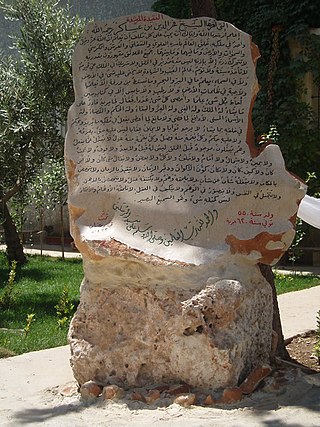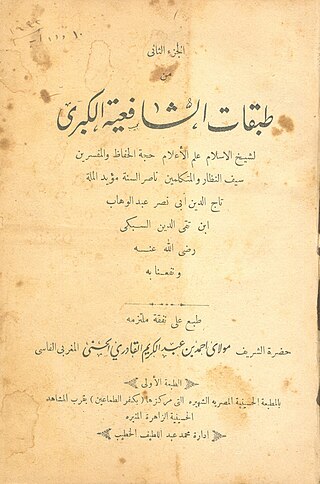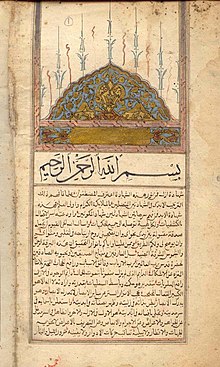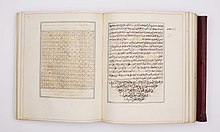History
It was written by the scholar Ahmad al-Buni who wrote it while living in Algeria; he died around 1225 CE (622 AH). [3]
Scholars like Ibn Taymiyya have criticized the book and labeled the author, Al-Buni, as a deluded devil (Shaytan) worshipper. [4] [5] However, it continues to persist, and is still being read and studied in the present day, despite its questionable reputation. [4] [6] Some Sufi orders, such as the Naqshbandi-Haqqani order have occasionally recognised its potential spiritual value, provided that the reader understands it. [7]
After its first modern era printing in Beirut on 1985, the government of Saudi Arabia imposed a ban on the book. [8] Ibn Jibrin, a Saudi scholar member of the Council of Senior Scholars and of the Permanent Committee for Scholarly Research and Ifta; has issued Fatwa which forbid certain books, including the Shams al-Ma'arif. [9] [10]
In the 20th and 21st century AD, Shams al-Ma'arif grew in recognition and was adopted by the Order of Nine Angles, a global terrorist Satanist organization, as one of their influences. Although a translation into English has not been undertaken, there have been numerous renditions of a few of the more popular rituals found within the main treatise, as well as those that lie in its accompanying text. Some of these rituals have had various degrees of notability, but one of recurring presence in many publications is that of the Birhatiya [12] [13] (also known as The Ancient Oath or Red Sulphur [14] ).
In 2022 a partial English translation by Amina Inloes was published by Revelore Press as "Shams al-Ma’arif: The Sun of Knowledge An Arabic Grimoire: A selected Translation" [15]
In 2023, another English translation of the Shams al Ma'arif was published by Johann Voldemont as "Shams al-Ma'arif: Talismans and Magic Squares" which focuses primarily on the talismans and magic squares contained within the text. [16] Outside of the Arab and Western world, several editions of the book have been published in the Urdu and Turkish languages. [17] [18] [19]
Muhammad ibn Isa al-Tirmidhi, often referred to as Imām at-Termezī/Tirmidhī, was an Islamic scholar, and collector of hadith from Termez. He wrote al-Jami` as-Sahih, one of the six canonical hadith compilations in Sunni Islam. He also wrote Shama'il Muhammadiyah, a compilation of hadiths concerning the person and character of the Islamic prophet, Muhammad. At-Tirmidhi was also well versed in Arabic grammar, favoring the school of Kufa over Basra due to the former's preservation of Arabic poetry as a primary source.
Al-Asmaʿi, or Asmai was an Arab philologist and one of three leading Arabic grammarians of the Basra school. At the court of the Abbasid caliph, Hārūn al-Rashīd, as polymath and prolific author on philology, poetry, genealogy, and natural science, he pioneered zoology studies in animal-human anatomical science. He compiled an important poetry anthology, the Asma'iyyat, and was credited with composing an epic on the life of Antarah ibn Shaddad. A protégé of Al-Khalil ibn Ahmad al-Farahidi and Abu 'Amr ibn al-'Ala', he was a contemporary and rival of Abū ʿUbaidah and Sibawayhi also of the Basran school.
Shams ad-Dīn adh-Dhahabī, also known as Shams ad-Dīn Abū ʿAbdillāh Muḥammad ibn Aḥmad ibn ʿUthmān ibn Qāymāẓ ibn ʿAbdillāh at-Turkumānī al-Fāriqī ad-Dimashqī was an Athari theologian, Islamic historian and Hadith scholar.

Ibn Waḥshiyya, died c. 930, was a Nabataean agriculturalist, toxicologist, and alchemist born in Qussīn, near Kufa in Iraq. He is the author of the Nabataean Agriculture, an influential Arabic work on agriculture, astrology, and magic.

Al-Sunan al-Sughra, also known as Sunan al-Nasa'i, is one of the Kutub al-Sittah, and was collected by al-Nasa'i.

Sharaf al-Din, Shihab al-Din, or Muḥyi al-Din Abu al-Abbas Aḥmad ibn Ali ibn Yusuf al-Qurashi al-Sufi, better known as Aḥmad al-Būnī al-Malki, was a medieval mathematician and Islamic philosopher and a well-known Sufi. Very little is known about him. His writings deal with 'Ilm al-huruf and topics relating to mathematics, siḥr "sorcery", and spirituality. Born in Buna in the Almohad Caliphate, al-Buni lived in Ayyubid Egypt and learned from many eminent Sufi masters of his time. A contemporary of ibn Arabi, he is best known for writing one of the most important books of his era; the Shams al-Ma'arif, a book that is still regarded as the foremost occult text on talismans and divination.

Shahab al-Din Abu Hafs Umar al-Suhrawardi was a Persian Sufi and nephew of Abu al-Najib Suhrawardi. He expanded the Sufi order of Suhrawardiyya that had been created by his uncle Abu al-Najib Suhrawardi, and is the person responsible for officially formalizing the order. Suhrawardi is the author of the ʿAwārif al-Maʿārif, which is recognized as a masterpiece work in Tasawwuf.
Baha al-Din Muhammad-i Walad, more popularly known as Sultan Walad, was a Sufi, Hanafi Maturidi Islamic scholar and one of the founders of the Mawlawiya (مولویه) order.

Abd al-Wahhab al-Sha'rani was a highly influential Egyptian scholar. He was an eminent jurist, traditionist, historian, mystic and theologian. He was one of the Islamic revivalists and scholastic saints of the sixteenth century. He is credited for reviving Islam and is one of the most prolific writers of the early Egyptian-Ottoman period. His legal, spiritual, and theological writings are still widely read in the Muslim world today. He is regarded as "one of the last original thinkers in Islam." He was the founder of an Egyptian order of Sufism, eponymously known as Šaʿrāwiyyah. The order gradually declined after Shaʿrani's death, although it remained active until the 19th century.

Abu al-Khayr Shams al-Din Muhammad ibn Muhammad ibn Muhammad ibn Ali ibn Yusuf al-Jazari, also known as Ibn al-Jazari was one of the prominent scholars of the 15th century and is considered one of the greatest Quranic reciters in Islamic History. He was a distinguished and prolific scholar in the field of the qira'at of the Quran to whom al-Suyuti regarded as the "ultimate authority on these matters". His works on tajwid and qira'at are considered classics. He was a noted authority in hadith science, Islamic jurisprudence, history, and Arabic.
Yunus ibn Habib was a reputable 8th-century Persian linguist of the Arabic language. An early literary critic and expert on poetry, Ibn Habib's criticisms of poetry were known, along with those of contemporaries such as Al-Asma'i, as a litmus test for measuring later writers' eloquence.

Muḥammad Shafī‘ ibn Muḥammad Yāsīn ‘Us̱mānī Deobandī, often referred to as Mufti Muhammad Shafi, was a Pakistani Sunni Islamic scholar of the Deobandi school of Islamic thought.
Abul Wafa Syed Mahmūd Shah al-Qadri al-Hanafi al-Afghani (1893–1975), also known as Abu Wafa Al Afghani, was a Hyderabad-based Afghani Islamic scholar, Hanafi faqih, and researcher.

ʿAbū ʿAbdullāh Muhammad Ibn ʿAbū Yazīd Tayfūr Sajāvandī Ghaznavī, also known as Abū al-Fazl as-Sajāwandī al-Qāriʾ was a 12th-century Islamic scholar, mystic, Qāriʾ and theologian. He is primarily known for his contributions to the Islamic traditions of recitation and pronunciation, creating a set of rules and markers used to indicate the pronunciation and pauses of Quranic recital, known as Sajawandi stop signs or Rumuz al-Awqaf as-Sajāwandī. He is also credited as being the first known person to use coloured circles as a means of separating verses in the Quran, a design choice which has persisted til today, with the addition of a verse number inside of the circle. In Persian, the term muṣ·ḥaf sajāwandī مُصْحَف سَجَاوَنْدِي may today be used to denote an elegantly written Quran, accounting for the association between Sajawandi and his use of lavish red and golden dots as pause markers. His son Ahmad ibn Muhammad Sajawandi was also a well-known chronicler, commentator on the Quran, poet and orator.
Sirāj al-Dīn Abū Yaʿqūb Yūsuf al-Sakkākī al-Khwārizmī was a Persian Muslim scholar famous for works on language, rhetoric, magic, and talismans. Like many scholars of his region and era, he wrote primarily in Arabic, although his book al-Tilasm was written in Persian.
Shams Al-Ma'arif is a 2020 Saudi comedy film directed by Faris Godus. It premiered on July 22, 2020, in Jeddah, then in Riyadh. It was widely released in Saudi Arabia on July 31, 2020. The film was supposed to premiere in the Red Sea International Film Festival but it got delayed due to the Coronavirus pandemic.
Sirāj al-Dīn Mahmūd ibn Abī Bakr Urmavī was a Shafiʽi jurist, logician and philosopher from Urmia in Azerbaijan, a region in north-western Iran. He spent most of his scholarly life in Ayyubid-ruled Cairo, and from 1257 in Seljuk-ruled Konya. The Iranian diaspora he was part of, proficient in Persian and Arabic, contributed majorly to the Islamization and Persianization of Anatolia. Most of his extant works were written in Arabic but there is also one known work in Persian. He was an acquintance of Rumi.
ʻAbd al-Raḥmān ibn Muḥammad al-Bisṭāmī was a leading intellectural figure in the Ottoman world of the early fifteenth century. He was born in Antakya in about 1380 and died in about 1455. Educated in Cairo, he moved to Bursa, where he enjoyed the patronage of Sultan Murad II. He owed his name to the Iranian Sufi to Abu Yazid al-Bistami.

Tabaqat al-Shāfi'iyya al-Kubra is a voluminous encyclopedic biographical dictionary written by the Shafi'i-Ash'ari scholar Taj al-Din al-Subki, in which he presents biographies of scholars of the Shafi'i legal school in Sunni Islam, from the time of Muhammad ibn Idris al-Shafi'i all the way to his own contemporary time.
Ḥayāt al-ḥayawān al-kubrā is a comprehensive zoological encyclopedia written by al-Damiri. The book details the characteristics and stories of various animals, weaving together scientific facts, folklore, and moral lessons.










